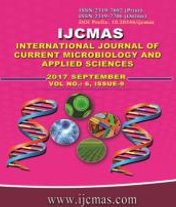


 National Academy of Agricultural Sciences (NAAS)
National Academy of Agricultural Sciences (NAAS)

|
PRINT ISSN : 2319-7692
Online ISSN : 2319-7706 Issues : 12 per year Publisher : Excellent Publishers Email : editorijcmas@gmail.com / submit@ijcmas.com Editor-in-chief: Dr.M.Prakash Index Copernicus ICV 2018: 95.39 NAAS RATING 2020: 5.38 |
A field experiment was conducted at Raipur, during kharif season of 2013 in factorial randomized block design with four replications to assess the effect of planting geometry on grain yield, zinc concentration, zinc yield and soil available zinc content of high zinc rice. Treatment comprised of three planting geometry viz., 10cm x 10cm, 15cm x 10cm and 20cm x 10cm and three levels of nutrient viz., 50%, 100% and 150% recommended dose of fertilizers (RDF). Recommended level of nutrient was 80:50:30 kg NPK/ha. Test variety was R-RHZ-1 which was short duration. The study revealed that planting geometry of 20cm x 10cm recorded higher grain yield, zinc concentration, zinc yield and zinc uptake as compared to other planting geometry. Planting geometry of 20cm x 10cm exhibited increase of 11.98 and 15.14% in grain yield, 3.37 and 4.65% in zinc concentration in grain, 6.44 and 9.98% in zinc yield and 5.79 and 9.30% in zinc uptake, however, soil available zinc was 11.98 and 15.14% lesser as compared to closer planting geometry of 15cm x 10cm and 10cm x 10cm, respectively. Among different nutrient levels, application of 150% RDF produced higher grain yield, zinc yield and zinc uptake, however, zinc concentration and soil available zinc content were higher under 50% RDF. Application of 150% RDF recorded increase of 12.81 and 7.09% in grain yield, 7.17 and 6.83% in zinc yield and 6.40 and 6.86% in zinc uptake as compared to 50% RDF and 100% RDF, respectively. Moreover, zinc concentration was 5.69 and 0.13% and available zinc content was 10.76 and 3.03% lesser with application of 150% RDF as compared to 50% RDF and 100% RDF, respectively.
 |
 |
 |
 |
 |